July 31, 2014
Bike New Yorker #10: Ilya and Kasia of Redbeard Bikes

We talked to Ilya Nikhamin and Kasia Nikhamina, husband-and-wife owners of Redbeard Bikes, about why they chose DUMBO as the location for their store, why more New Yorkers should experience the joy of riding a bike, and about the difficulties of running a business with your spouse.
Your shop used to be located around the corner, on Front St. When did that shop open?
Ilya: Right around the time Hurricane Sandy hit. We were scheduled to open November 1st. But we delayed it because that was two days after Sandy. November 7th was the next scheduled day, and that was the day of the freak snowstorm.
Born under a bad sign.
Ilya: Yeah, so we opened in November 2012. We were open there for exactly a year, and then this lease came up, and we switched with the same landlord.
It was too small for you over there?
Ilya: We were busting at the seams. We had a storage space.
Kasia: The storage space was three or four blocks down, so all day long from May through September, we were running up and down the street. Mostly me.
Ilya: I’d be with a customer. And then it’d be, “Oh, you want to see the RED one… hang on…” or “oh, you’re here to pick up your repair? Hang on…”
Kasia: And then while I’m running there with the heavy Schwinn, he’s calling me, telling me to bring the Colnago, too.
So what were you doing before you opened the first shop?
Ilya: I worked in a bike shop for nine years. Right from high school, I just started working in the shop part time and then continued to work there and figure things out. I was also going to school at the time.
Where was the shop?
Ilya: This was in Sheepshead Bay. I worked at Roy’s Bikes. I lived down there and I also went to college at the same time, at Brooklyn College. Seven years of college plus nine years of the bike shop basically told me to quit both and just do something else. After sitting around for awhile, I realized that people who have worked in a bike shop for nine years and don’t have a college degree can’t get actual jobs. After realizing that, it was like, well, what do I know how to do? And: Bike shop. That was it.
Seven years of college plus nine years of the bike shop basically told me to quit both and just do something else.
Kasia: You had some photography in there, some acting… he acted in my play.
Ilya: So we did the business plan competition at the Brooklyn Public Library. They have this competition called PowerUP!. It’s not so much systematized, where you learn everything from scratch, it’s very motivational and you get to see other people doing it and then run with an idea.
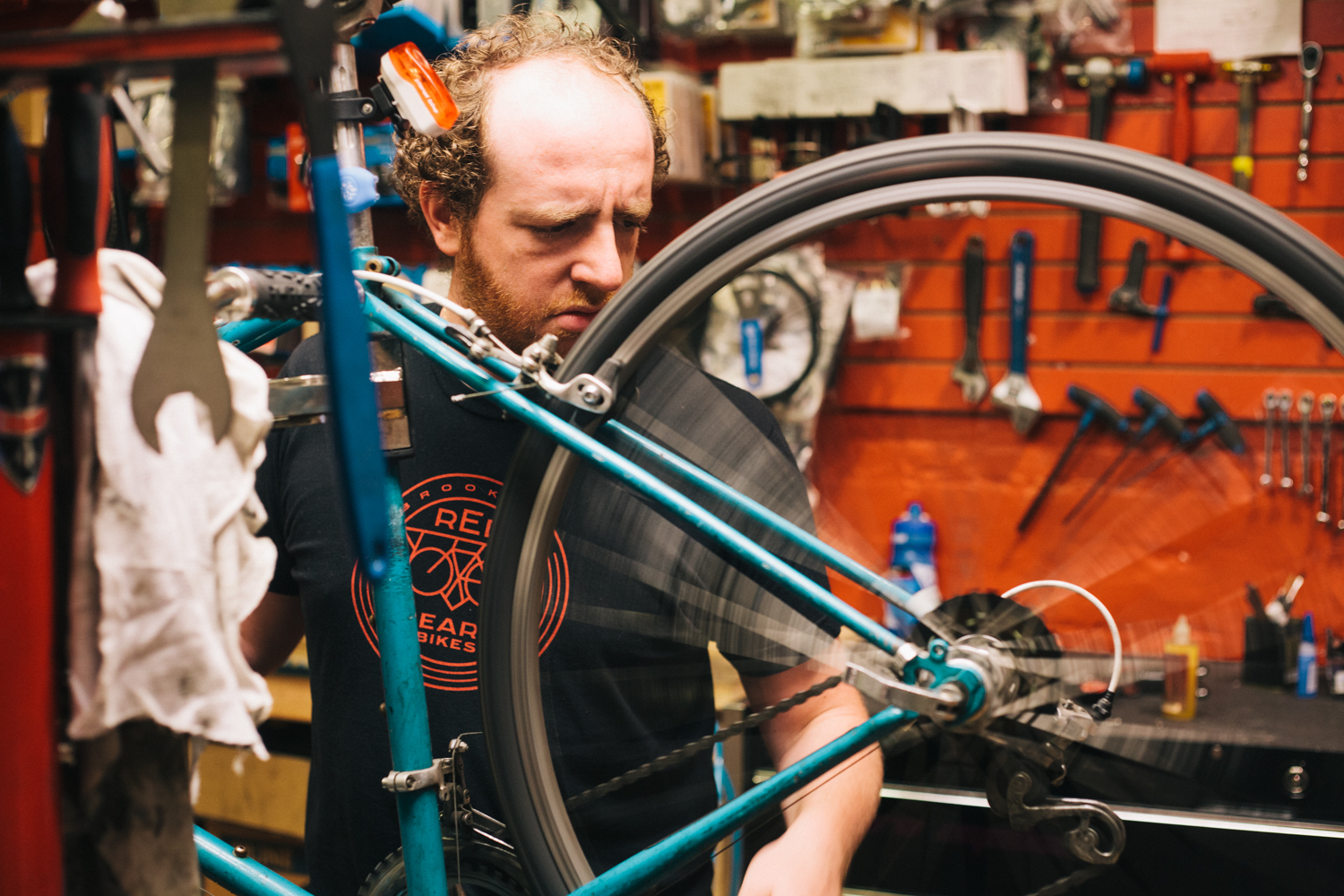
Did you win?
Ilya: I’ll put it this way: Before the competition was over, the shop was already open. Before the competition started, there wasn’t an idea about a shop. The competition made us consolidate the thought process of what we wanted to do. It turned into a bike shop idea, and the finalist interviews and the awards ceremony both required me to close the shop early to go to them.
Kasia: Yeah, it was in November or December.
Ilya: Presenting a business plan required me to close the business.
I bet they were shocked.
Kasia: Yeah, we went to give our presentation, and we’re like, “yeah, our shop’s a few blocks away.” It was good.
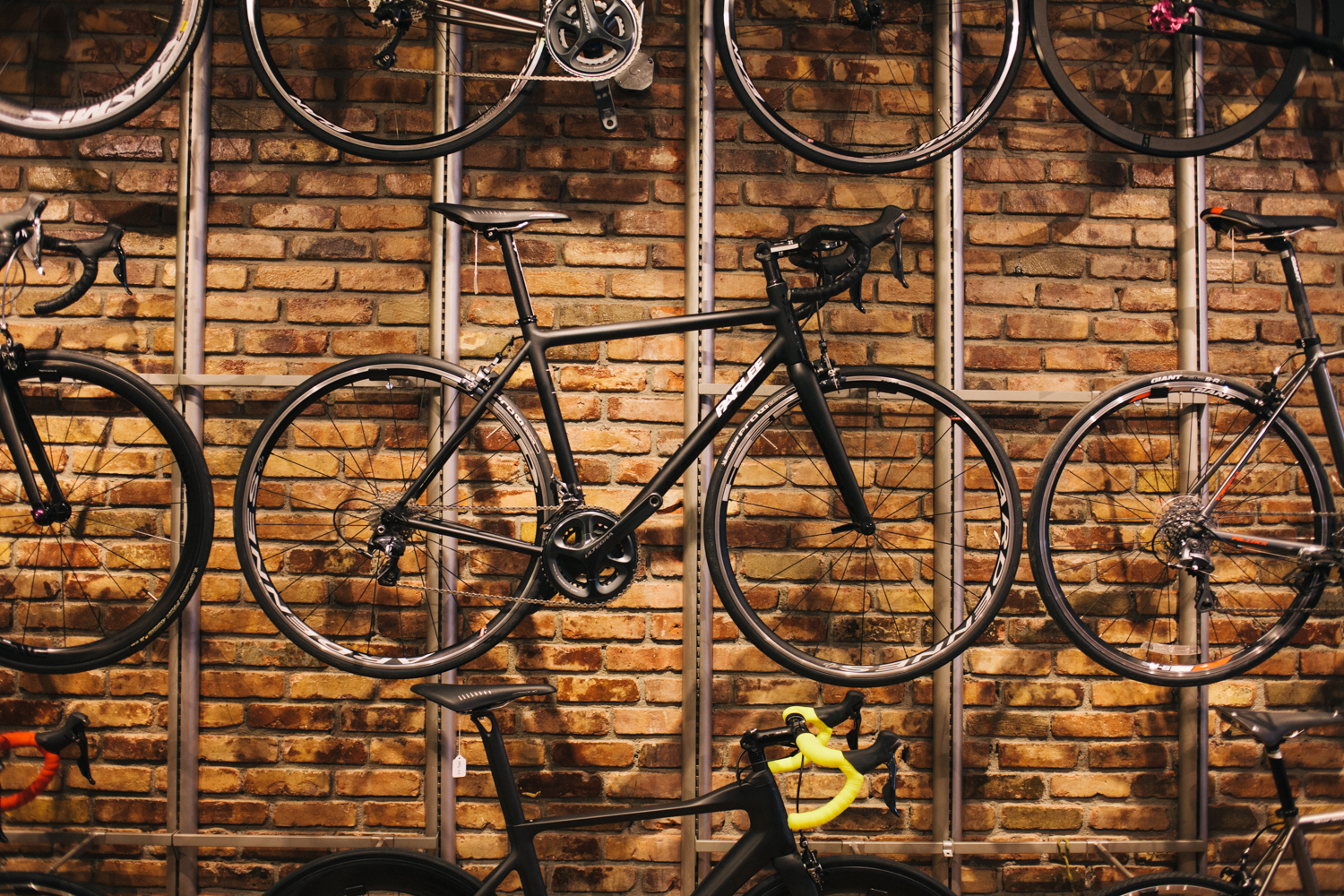
I bet that for someone who’s into bikes, being a bike shop owner must be rewarding. You’re surrounded by things that you love.
Ilya: Yeah, well… there’s a theory I came up with awhile ago that all of the most successful shops are run by people who don’t ride. Same goes for most bike companies. A really good example of this is the guy who founded Giant bicycles. He built the world’s largest bicycle company, by far, and he just took up cycling five years ago. He’s in his 70s. So you could be into bikes, but what’s interesting is how far the bike business can take you away from riding a bike. If you work six or seven days a week and you’re always talking about bikes, and you’re always on your feet, it doesn’t leave that much energy for actual bikes. It’s an interesting double-edged sword. But yes, I absolutely do enjoy it. The goal of the shop was to bring cycling more into the forefront, not make it something that’s a discussion, but something that’s a no-brainer.
If you work six or seven days a week and you’re always talking about bikes, and you’re always on your feet, it doesn’t leave that much energy for actual bikes. It’s an interesting double-edged sword.
Do you derive satisfaction from that? “There’s one more happy cyclist on the streets, enjoying bikes.”
Ilya: Absolutely. I like ticking that box. Sometimes I have to stop and think about it. We’re getting people out on the street, riding. It’s nice. It’s a good thing.
And you, Kasia, didn’t come from a bike shop background…
Kasia: …Other than our living room, which was our first bike shop.
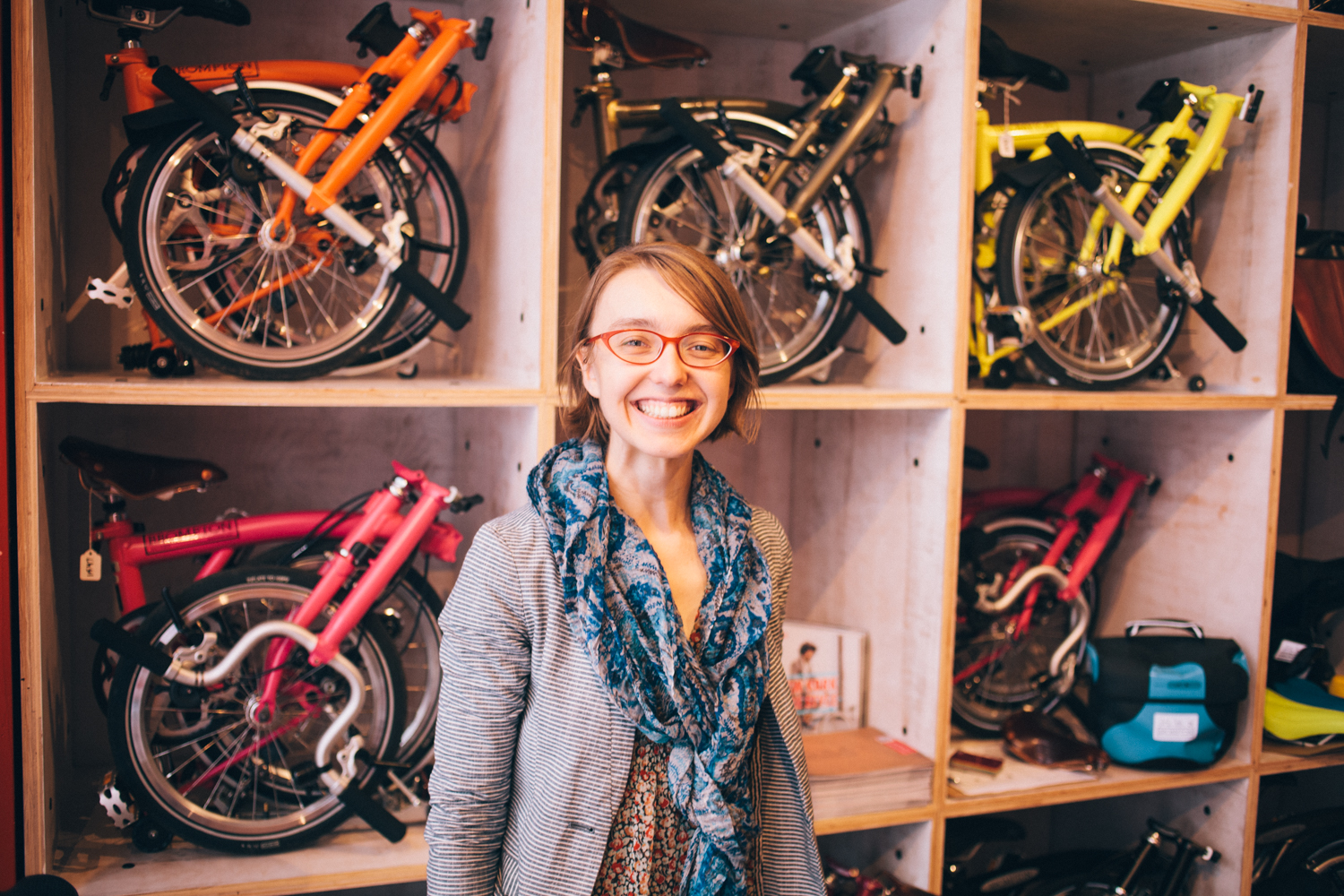

When did you first two meet each other?
Kasia: We met in high school. The first day. We were dating for a while and then we got married right after I graduated college, back in ‘07. I rode a bike as a kid, but Ilya got me into riding in general, in the city. I didn’t ever think I would end up working at a bike shop. My primary passion in life is writing. But I’ve always done office jobs of various sorts, and I spent a stint at the Manhattan D.A.’s office right after college, which was interesting, and then I worked at a place called D. E. Shaw for almost three years in investor relations. I would go there in the morning and go to DUMBO at night and on weekends and help out at the shop. It got to be too much, so I made the leap. I’m full-time here as of last July.
Is it all you had hoped it would be?
Kasia: It’s a lot more work than any job I’ve ever done. But I’m happy I’m not working in an office anymore. [Pauses] It’s hard to work with your spouse. But it is wonderful in a way. There are moments that are really good. It’s just a big process and an adventure to figure out the balance and make it work.
What didn’t you expect?
Kasia: Hmmm…
Ilya: We’re business owners. We expect everything.
Kasia: I didn’t expect how hard it would be to make a mistake and be told that you made a mistake by your spouse. It’s hard to keep personal and professional separate.
Why DUMBO?
Ilya: We came here for a play once at St. Ann’s. And then one time we just came here to walk around the neighborhood. We saw all the bikes around and thought that there should be a bike shop here. And it had to do with the small intricacies of the small bike world, having been doing this for nine years in Brooklyn, I know where all of the other shops opened up and exactly what everybody specialized in.
Kasia: No pun intended.
Ilya: It’s a specific kind of neighborhood where there are a lot of commuters but there are a lot of people with money. It’s a good mix of wealth and commuting. When I first came up with the idea of a bike shop, I was thinking… and this literally changed throughout the biz plan writing competition… the first idea was to have a bike fit studio where we did bike fittings for high-end bikes, by appointment only, and quickly after realized that would be boring, thought it would be cool to do a ground floor retail place.
Kasia: He originally looked at studios at 10 Jay St.
To do private fittings.
Ilya: Which is what I specialize in and really kind of know, and I think there’s a real lack of in the high-end bike shop world. So that was the original driver in DUMBO, because there was a combination of a high-end clientele and studio space. So it would have been fairly easy to get the business rolling.
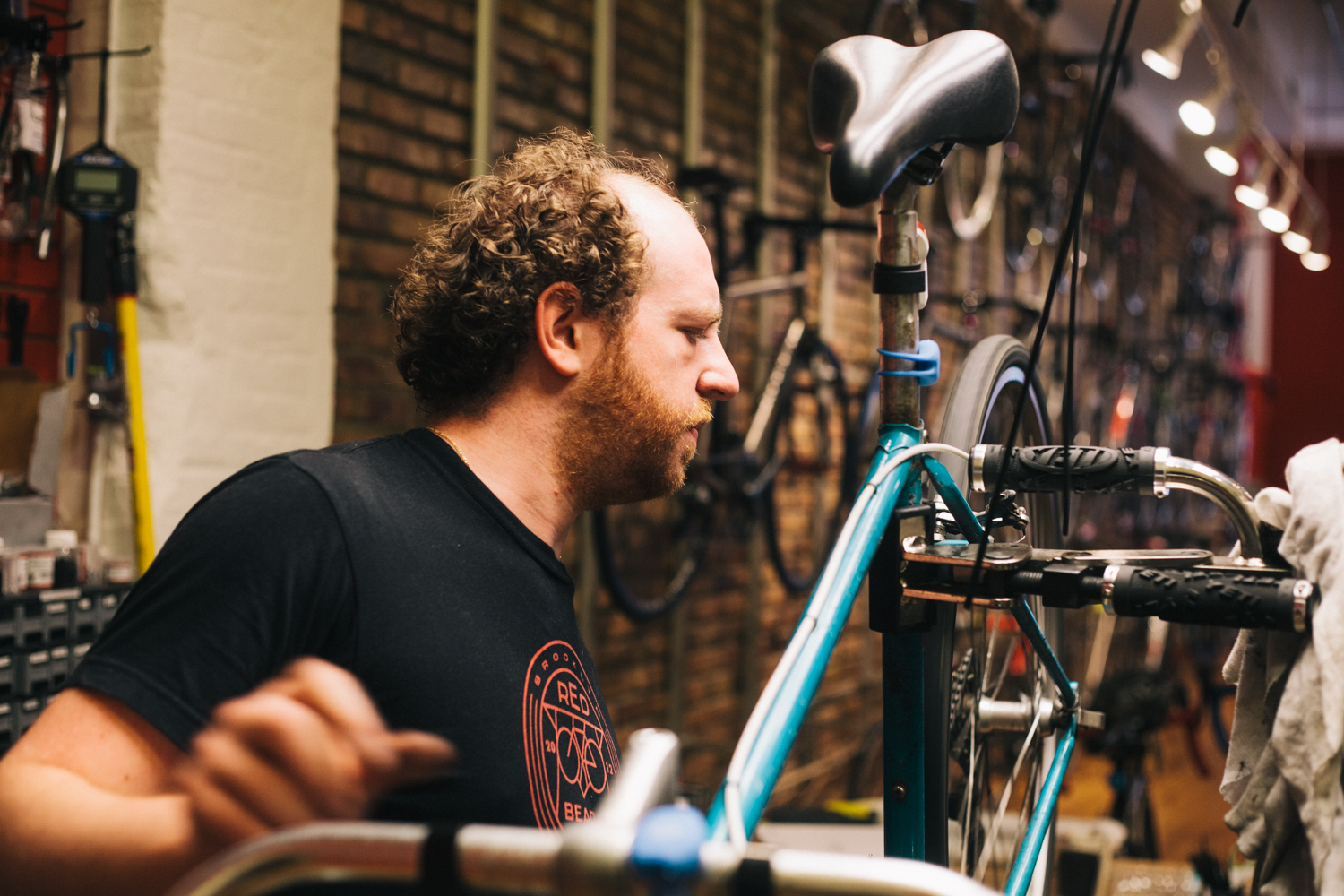
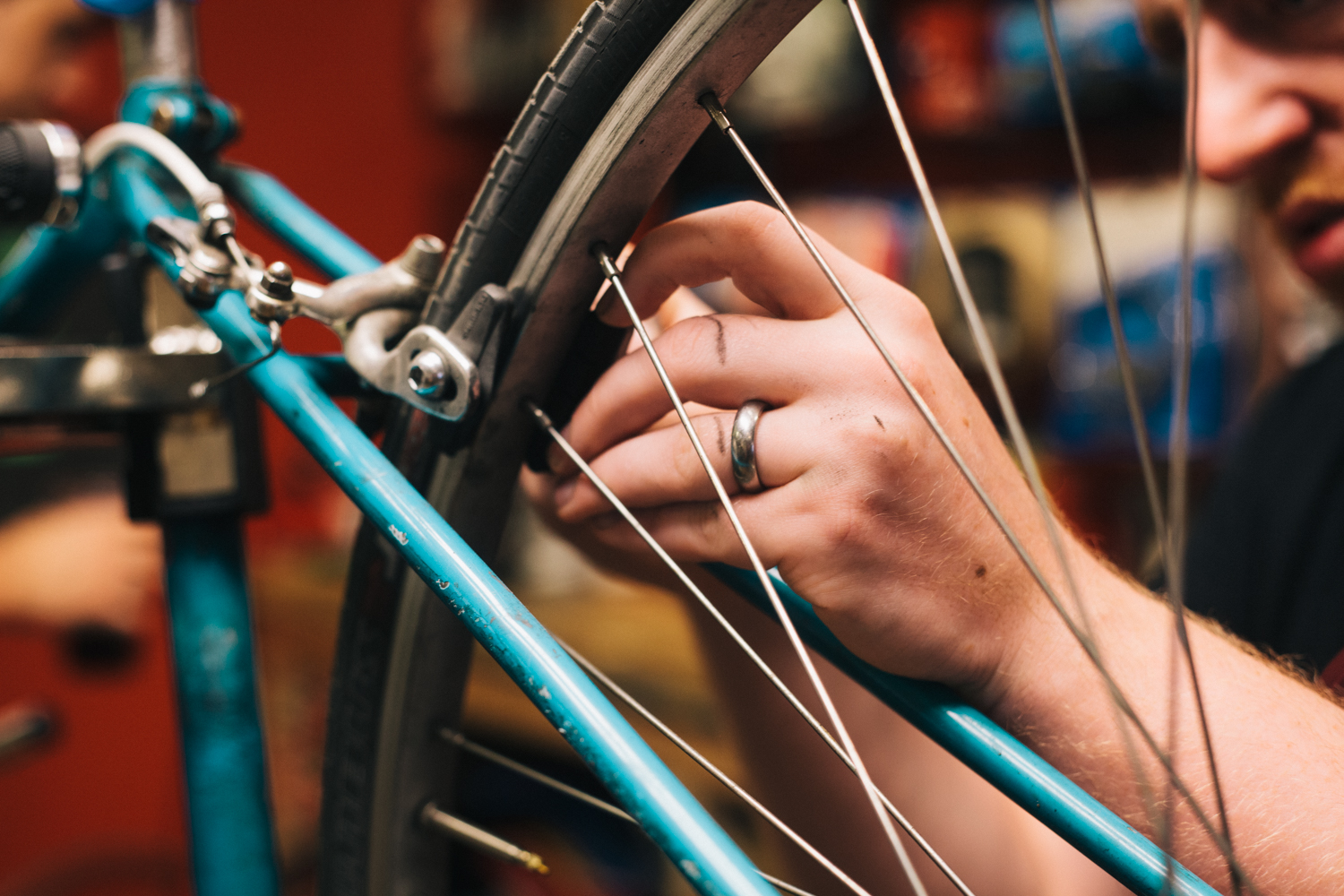
I remember a conversation we had back when we were doing a video shoot for the TD Five Boro Bike Tour bag restrictions. You blew my mind a little when we were talking about bike frame materials, and you had a theory…
Ilya: Ha! That’s my “theory.”
I think it’s a great theory, and I’d like to hear it again, and it has to do with resonant frequencies.
Ilya: Can this be something that is unresearched and unvalidated?
I’m not going to fact check this, if that’s what you mean.
Ilya: Fact check it, please! Tell me if I‘m right or wrong! Ok, well, this is strictly speaking, a theory. What’s a better word… “Conjecture.” An idea.
Kasia: I have no idea what’s coming next.
Ilya: So the idea is that different bike materials behave differently on the road. The bike will transmit the vibrations from the road surface at different frequencies, whether it’s steel, alumni or carbon or a couple of others out there. This specific set of vibrations that each bike material or each bike will send up our way is very unique and very different. Its kind of the signature to the material. My thinking is that carbon fiber, while an excellent material in many ways, doesn’t send the same signals, so we interpret the road surface differently. Just like the body has rhythms for so many of the actions at the cellular level, like we know that neurons fire at certain frequencies with certain thresholds, there are time gaps… we know that the body can’t respond infinitely… there are gaps, there are pulses… so some of the frequencies that we pick up on the road tell us one story, and others tell us another. So if you’re flying down a mountain at 50MPH, you don’t want to be thinking about it; you want that response to be on the cellular level. So the reasoning is that steel and titanium have a really nice singing, vibrating sensation to them which directly corresponds with the way that we already perceive the world. When we hear the wind rushing past our ears, we can kind of judge whether the wind is fast or slow, but to damp that or screw around with the sensations we get, we wouldn’t be able to judge the speed accurately. Same thing with bicycles. When you mess around with the incoming sensations, you don’t have a gut instinctual idea of how fast you’re going or what the bike and the road are doing. The thinking is, look at how much faster the bikes have gotten today. And think about the fact that 40 years ago, the pros were flying down the hill just as fast but with far worse brakes and way worse tires, so there’s something to be said about how they could feel the road more. That’s the hatchling of the idea.
We’ll let readers come in and ask you to expand on it.
Ilya: If this gets me in trouble, I will find you.
It sounds like it makes sense when you think about the way our senses work and how we experience the world around us. The world isn’t a TV screen around you… there are other senses. There are people who can taste metal if there’s something nearby, they can taste it through the air. There are definitely lots of ways that we experience the world that we don’t necessarily understand.
Kasia: I just rode a carbon fiber bike for the first time in California and it blew me away how different it ways from my Ti bike.
Ilya, what do you ride right now? I’m assuming you have a many rides. What’s your favorite right now?
Ilya: The F train.
Do you go for joyrides together?
Kasia: We’ve been riding home a lot more. The late night rides. We’ve also started doing shop rides. I’m trying to do a ladies’ ride every Thursday night. I started this before and kind of didn’t keep it up, but I’m trying it again now. It’s a lot of work to regularly do it and promote it. Basically just in Prospect Park, just a workout ride, to get people out there to ride and get their heart rates up.
You primarily promote it through customers?
Kasia: We’ve done some social media around it, but mostly I try to tell people about it when they come in. Especially for the women’s ride. If they’re getting a road bike, or if they’re new to the neighborhood, I talk it up a bit. I find that that goes a longer way than internet posts. And then our shop ride is on Sundays. It was Ilya’s idea.
Ilya: We’re trying to figure out a way to make it a more involved ride and also a ride that more people attend, but I want to try to promote a bit of “non- a–hole” road cycling in the city and I think that would be a fun experience for everyone but at the same time also create a community of people who enjoy riding ANY type of bike, who enjoy the challenge of going farther and going faster. Most people bring road bikes, a couple of people have brought Bromptons, some single speeds, and then it’s just… the whole concept is a “no drop” ride. Some people can go faster, because it’s a no-drop ride, something that doesn’t really exist in New York, because we have group A, we have group B, we have group C. And you better not get dropped from group C, because there isn’t a group D. There’s just the “go do your laps on your own” group. But it’s a big thing in the rest of the country. There are plenty of no drop rides all over the place. New York is behind the times in terms of cycling community. That’s one of the reasons I really hope the ladies ride takes off. If you look at New York ridership in terms of numbers on the road, there are far fewer women on the road. It’s maybe 10 percent, and I think it’s less than that. If you go to the West Coast, it’s a whole other story.
Kasia: In some ways, we have a lot of commuters—and commuting by bike is awesome and we love it—I feel like there’s not a lot being done to grow the number of recreational riders. There are the people who race bikes, and there are some women on the teams, and the clubs and whatever, but there aren’t a lot who are trying to bridge the gap. There are a lot of commuters out there who want to ride, or have it in them to ride recreationally. It’s a fun sport! So that’s what I’m trying to grow a little bit with the ladies’ rides. I just discovered a year ago that I love riding just for the sake of riding. I used to just commute. And I think there are a lot of people out there like that.
When did you discover that you liked riding?
Kasia: It had to do with the shop… I went through some kind of transformation, I don’t know…
Ilya: It’s different from riding to commute and it’s different from riding to explore something and its different from going on a vacation ride. It’s riding to ride. And nothing else. The destination almost doesn’t matter. Nothing really matters except the ride itself.
Kasia: It’s a meditative experience.
Ilya: People completely miss the fact that there’s a joy to riding. And one of the best ways that this manifests itself… we have the Parlee bike over here, it’s an $11,000 carbon bike, it’s very light; and one of the most commonly asked questions that we get in the store is, “How would you lock that up?” Because the interpretation of a bicycle for the person asking is to commute on his bicycle. No. I don’t think everyone needs a high-end road bike to ride fast and to ride for joy, but it’s something that exists that a lot of people are just missing. You can have joy in riding, you can have joy in your bike. It doesn’t matter what the bike is, but once you understand that a bike is not just a tool to get from point A to point B, which it is an excellent tool for, you get to open up a whole other thing. Who doesn’t love going fast? It’s awesome. People forget that.
Kasia: But there are opportunities for it, and I think that’s really what we’re trying to get at.
Prospect Park is a good place.
Kasia: Yeah but it depends on when. They have those great concerts, but man, it gets so crowded now, so even nighttime is not an escape. You have to go at 11 pm.
Yeah. Ok, so Ilya rides the F train…
Kasia: Oh, Ilya rides a Lynskey and a Brompton. He alternates.
Ilya: The bikes that we own are the bikes that we sell. It started out as owning them and then deciding to sell them because we liked them so much that we thought that everybody should have them.
Kasia: We each have a Brompton and we also have Lynskeys, our road bikes. That’s actually my favorite bike right now, and has been for a while. It’s what I try to ride as much as possible. But it’s not lockable. I find myself changing my life habits a bit. Not getting the cereal on the way home because I can’t go into the grocery store.
Recycle-A-Bicycle is down the street. Do you interact? Is there a DUMBO bike community?
Ilya: We like the idea of a second shop. That’s actually one of the reasons I opened here, is because Recycle-A-Bicycle is here. I wouldn’t be in a position where I couldn’t do certain work and there wasn’t a second bike shop to do that work. We work on mostly new bikes, but we work on tons of old bikes as well. We bring things from the dead. But we are able to better cover the needs of the community because we’re kind of split.

What’s next for Redbeard? I know you recently came out with some jerseys, what’s next in the business plan?
Ilya: Right now it’s sustaining. Summer is the busy season, when we keep up, and then fall and winter are when we consolidate and plan and think about things. One of the next things we’re looking for is sponsoring a local club, but its hard to think of everything outside of the daily grind. It’s “let’s finish building this cabinet…” put more lighting up so it looks better…
Kasia: … Clear the boxes, put stuff into our inventory system…
Ilya: … Make the website more reflective of reality…
Kasia: … Decide which brands to stop carrying and what to change, and what to reorder.. and how to pay for it. And how to find time to have dinner with our friends.
Ilya: Yeah. So the long picture is to sustain and to grow in the same general direction. The hard part is maintaining the same philosophy or ideology about the shop. It’s hard when there’s pressure to cave and change and do things the easy way.
Kasia: We don’t want to dilute it, to bring in a bunch of random brands just because.
Kasia, did the red glasses exist before Redbeard?
Kasia: Yeah. They’re actually what remains of my last flex dollars at my old job. I had red glasses before that, but they were a little more understated.


